Smart brushes will teach children to brush their teeth 2 minutes
Today, we offer you a selection of children's toothbrushes: there are few of them on the market in principle, however, probably more than you thought.
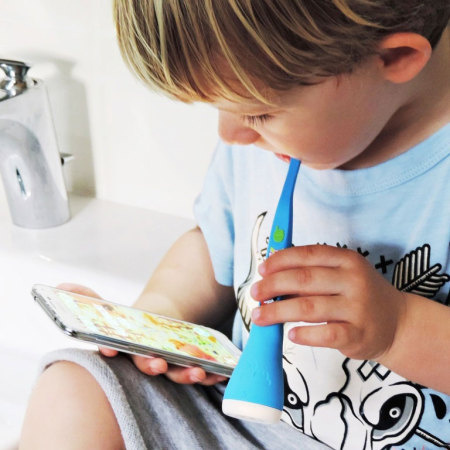
This is not the most popular niche of gadgets, however, as it seems to us, it is very useful, because many dental problems begin due to the lack of hygiene, which is laid at an early age.
Two minutes is not a time limit, but making the child just stand by the mirror and brushing his teeth during this time is not an easy task! In order to come up with interactive brushes, enticing process and habituating to systematic procedures. A few years ago, it all started with Kolibree.
Kolibree
One of the most important projects in this field, the most recognizable and "quoted", because - the first!

If you are thinking of looking for a smart baby brush on Google, then almost the entire first page will somehow display on this model.
It is quite expensive and today due to the lack of an impressive number of competitors, which, of course, makes it not the most accessible. The difference between this child (and all other) e-smart brushes and adult smart brushes is that the child brushes his teeth during the game.
Specially designed applications are two-minute games that both keep the child’s attention and make him brush from side to side, covering all his teeth.
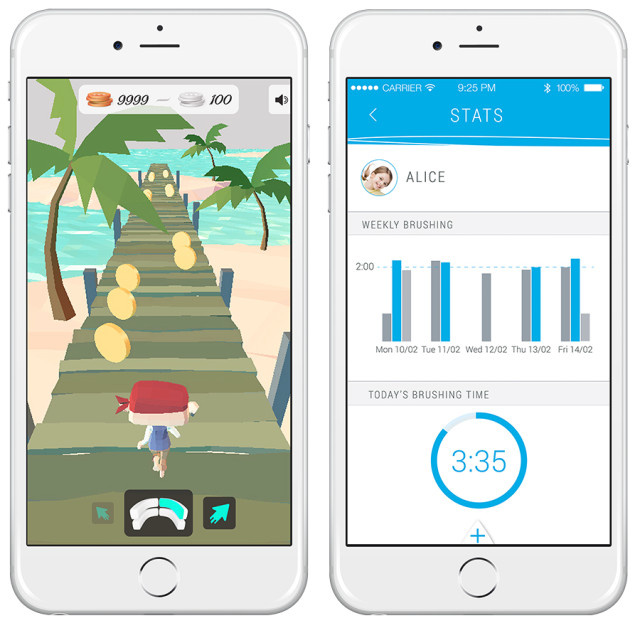
It is also necessary to say that adults can also use Kolibree, keeping statistics and analytics in the application.
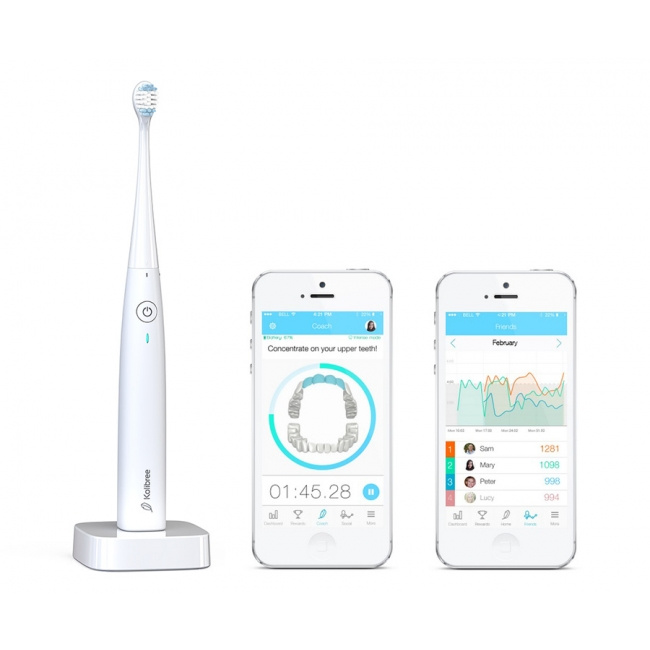
Grush
This is the second fairly well-known project, which arose shortly after Kolibree and is widely represented in foreign media. Enough detailed story about it is on Geektimes .

It is made simpler than Kolibree, which made it possible to reduce the cost visibly without losing the basic meaning. Grush also includes an application, the plot of which you need to fight with microbes for two minutes.
PlayBrush
The third most notable project, which you will also find among the first links, is a fairly new one - PlayBrush, with the developers of which we met at IFA.
This motivating device seems to us the most promising and interesting, at least because it is universal: the PlayBrush is a brush attachment. In other words, you do not need to buy a separate gadget, you do not need to think further about where to get the nozzles, etc. It is also worth saying that the responsibility for choosing a brush and bristle is shifted to the parents: you do not impose any cat in the bag.
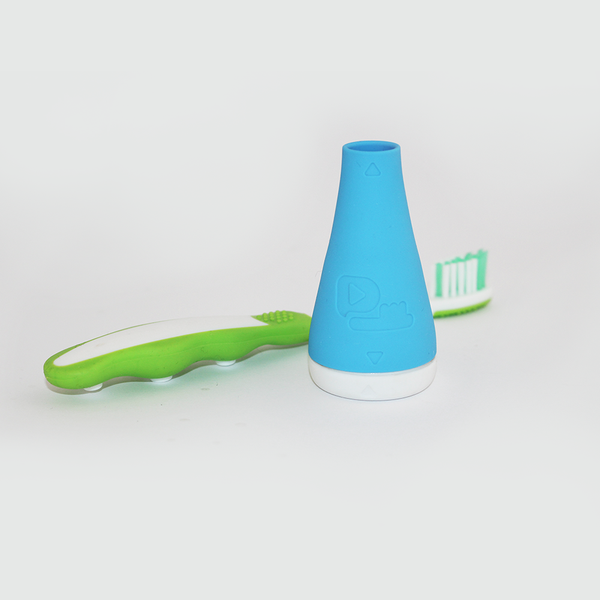
The silicone cap is put on any brush and synchronized with applications, and some of them are duplicated in the “boyish” and “girlish” versions.

The task is similar - to hold the child’s attention with a brush in the mouth for two minutes, and the plot of the game will ensure that the brush goes from side to side.

And finally, PlayBrush is very affordable, and you can leave a pre-order on our site.
I also liked the details of the kit: a special protective pocket for a smartphone is provided in the PlayBrush. If someone tried to brush their teeth and keep a smartphone near them without protection, they understand what they mean.
Not to mention other projects - one of the most famous, belonging to the brand with a world name, - Philips Sonicare .

Inexpensive brush that also works in tandem with a smartphone and offers to train perseverance in tandem with a free application.
Brush for adults, but also with a gamification element, - Beam . This is a closed project that collaborates with insurance companies.
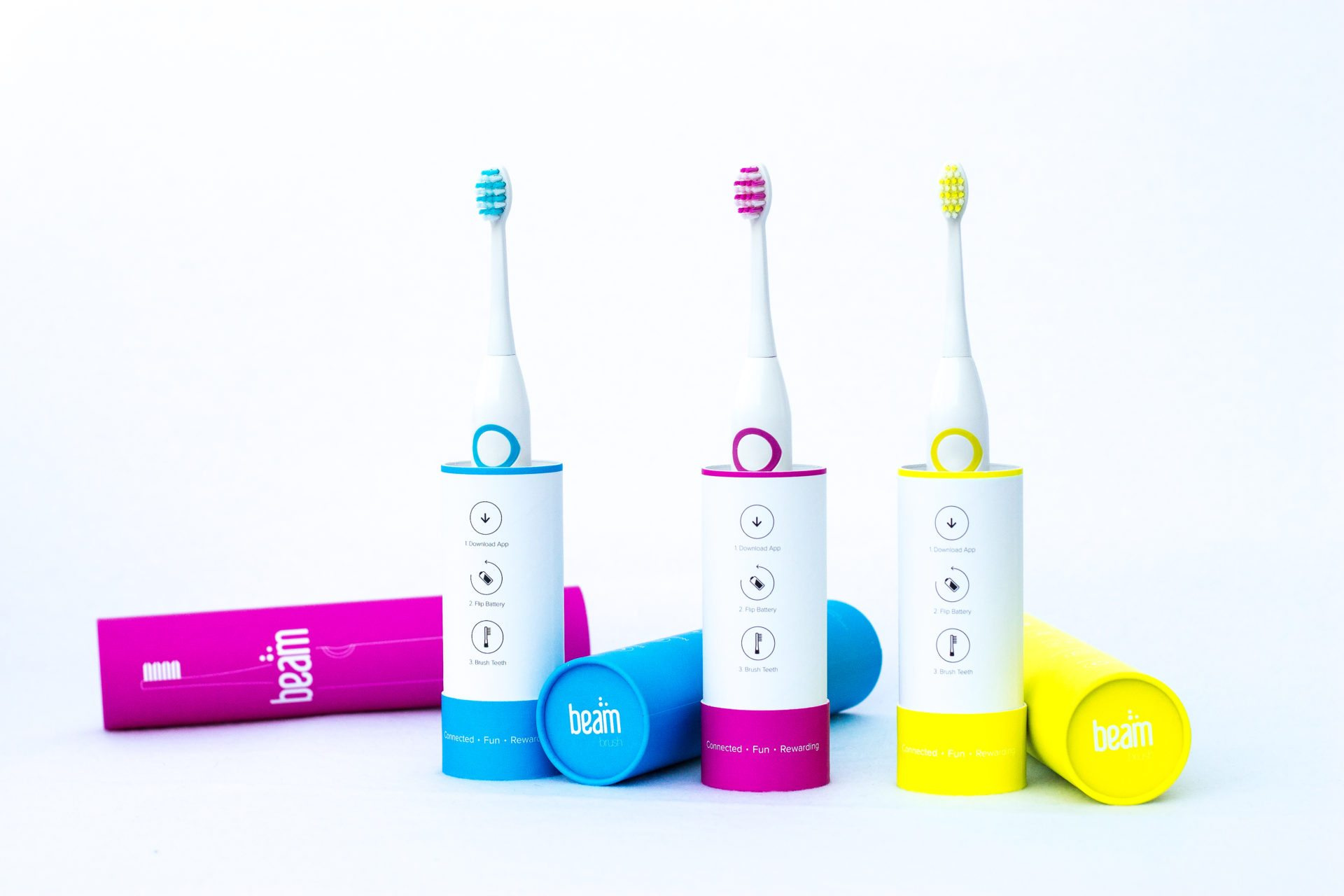
And finally, another interesting project, not very well known, visually similar to PlayBrush - Rainbow .

This is not quite a brush head attachment, and you are still held hostage by the nozzles, but all the other “classic” elements in the form of games and applications are present here. The models are designed for children and teenagers, and now the company is preparing to release an adult version.
In the final, let us quote ourselves:

This is not the most popular niche of gadgets, however, as it seems to us, it is very useful, because many dental problems begin due to the lack of hygiene, which is laid at an early age.
Two minutes is not a time limit, but making the child just stand by the mirror and brushing his teeth during this time is not an easy task! In order to come up with interactive brushes, enticing process and habituating to systematic procedures. A few years ago, it all started with Kolibree.
Kolibree
One of the most important projects in this field, the most recognizable and "quoted", because - the first!

If you are thinking of looking for a smart baby brush on Google, then almost the entire first page will somehow display on this model.
It is quite expensive and today due to the lack of an impressive number of competitors, which, of course, makes it not the most accessible. The difference between this child (and all other) e-smart brushes and adult smart brushes is that the child brushes his teeth during the game.
Specially designed applications are two-minute games that both keep the child’s attention and make him brush from side to side, covering all his teeth.

It is also necessary to say that adults can also use Kolibree, keeping statistics and analytics in the application.

Grush
This is the second fairly well-known project, which arose shortly after Kolibree and is widely represented in foreign media. Enough detailed story about it is on Geektimes .

It is made simpler than Kolibree, which made it possible to reduce the cost visibly without losing the basic meaning. Grush also includes an application, the plot of which you need to fight with microbes for two minutes.
PlayBrush
The third most notable project, which you will also find among the first links, is a fairly new one - PlayBrush, with the developers of which we met at IFA.
This motivating device seems to us the most promising and interesting, at least because it is universal: the PlayBrush is a brush attachment. In other words, you do not need to buy a separate gadget, you do not need to think further about where to get the nozzles, etc. It is also worth saying that the responsibility for choosing a brush and bristle is shifted to the parents: you do not impose any cat in the bag.

The silicone cap is put on any brush and synchronized with applications, and some of them are duplicated in the “boyish” and “girlish” versions.

The task is similar - to hold the child’s attention with a brush in the mouth for two minutes, and the plot of the game will ensure that the brush goes from side to side.

And finally, PlayBrush is very affordable, and you can leave a pre-order on our site.
I also liked the details of the kit: a special protective pocket for a smartphone is provided in the PlayBrush. If someone tried to brush their teeth and keep a smartphone near them without protection, they understand what they mean.
Not to mention other projects - one of the most famous, belonging to the brand with a world name, - Philips Sonicare .

Inexpensive brush that also works in tandem with a smartphone and offers to train perseverance in tandem with a free application.
Brush for adults, but also with a gamification element, - Beam . This is a closed project that collaborates with insurance companies.

And finally, another interesting project, not very well known, visually similar to PlayBrush - Rainbow .

This is not quite a brush head attachment, and you are still held hostage by the nozzles, but all the other “classic” elements in the form of games and applications are present here. The models are designed for children and teenagers, and now the company is preparing to release an adult version.
In the final, let us quote ourselves:
Baby teeth
The problem of cleaning children's teeth is considered from the point of view of two medical sciences: dentistry and psychology, each of which in its own way solves either the prerequisites or the consequences.
The result is most often Early Childhood Caries (Early Childhood Caries) - the most common disease. At present, this chronic disease is common in children under 6 years of age in 30–40% of cases, and the severe form of RDC in children under 3 years old in 12–15%. The disease is excited by bacteria, which use the fact that the nutrient medium remains in the oral cavity, including food pieces, etc.
Medicine, oddly enough, is practically powerless in front of the premises of such a disease, since its development takes place uncontrollably, at home, but since the dentists strongly "get", they formulated their wishes:
And there are always a few tips dedicated to brushing your teeth!
And then psychologists come to the rescue, as it is not always a simple process to teach a child to systematically brush their teeth. And the most "intersecting" advice that roams from article to article - Teeth brushing / training to brush your teeth should occur in a playful way.
A rather detailed decoding of this is suggested by Dr. Komarovsky , a well-known among mothers, where he offers, inter alia:
It is rightly noted that it is desirable to do an independent process from beginning to end, and the child himself must choose a toothbrush in order to increase responsibility.
The common advice that the “parody” model is effective, I do not share, because the child repeats the process in the grotesque form, the child does it very thoughtlessly, copying and not attaching any absolute value to it.
How do they grow
Just in case, I propose to recall the frequency with which, according to statistics, children's teeth appear. Although this should not be treated as a reference, it should not be, because the process is largely individual.
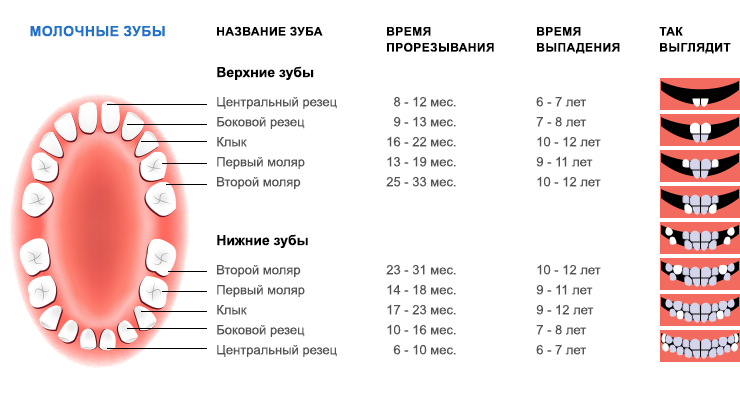
The child lives with baby teeth for a relatively short time and the first shifts begin by the 4th year. Most often the update sequence is the same as the growth sequence.
When to start brushing
From a psychological point of view, starting to care for the oral cavity is necessary even before the appearance of teeth. Now there are quite a few “brush-like” devices with rubberized tips that visually perform the toothbrush fukntion, formally helping the eruption of the first teeth.
The first hygiene procedures are still “not breaking away from the breast” or from the bottle, when half an hour after feeding the mother takes care with the help of special means for the infant's oral cavity. The tendency, when parents help a child to brush their teeth, persists up to about 2 years, and at this time it is recommended to carefully select the bristles of the first toothbrushes and generally be more careful with movements.
By the age of two, when children begin to do some things a little more consciously, it is time to get used to the toothbrush. And to the fact that we have said it remains to add that some parents, together with doctors, consider it expedient to separate the two processes from each other: cleaning the teeth and cleaning the oral cavity .
In the latter case it is a question that after each meal you can rinse your mouth or drink a glass of warm water, and this also affects the quality of teeth in the future.
The result is most often Early Childhood Caries (Early Childhood Caries) - the most common disease. At present, this chronic disease is common in children under 6 years of age in 30–40% of cases, and the severe form of RDC in children under 3 years old in 12–15%. The disease is excited by bacteria, which use the fact that the nutrient medium remains in the oral cavity, including food pieces, etc.
Medicine, oddly enough, is practically powerless in front of the premises of such a disease, since its development takes place uncontrollably, at home, but since the dentists strongly "get", they formulated their wishes:
- Do not overfeed baby at night
- Do not allow to fall asleep with a bottle
- Do not lick pacifiers so as not to transmit bacteria
- First tooth - first dentist
And there are always a few tips dedicated to brushing your teeth!
- Teach your child to brush their teeth systematically twice a day.
- Use a soft toothbrush, etc.
And then psychologists come to the rescue, as it is not always a simple process to teach a child to systematically brush their teeth. And the most "intersecting" advice that roams from article to article - Teeth brushing / training to brush your teeth should occur in a playful way.
A rather detailed decoding of this is suggested by Dr. Komarovsky , a well-known among mothers, where he offers, inter alia:
- Invent fairy tales and stories about teeth
- Attract toys
- Draw on teeth brushing
- Etc.
It is rightly noted that it is desirable to do an independent process from beginning to end, and the child himself must choose a toothbrush in order to increase responsibility.
The common advice that the “parody” model is effective, I do not share, because the child repeats the process in the grotesque form, the child does it very thoughtlessly, copying and not attaching any absolute value to it.
How do they grow
Just in case, I propose to recall the frequency with which, according to statistics, children's teeth appear. Although this should not be treated as a reference, it should not be, because the process is largely individual.
- 3 - 8 months - central teeth, incisors, first from the bottom, then from the top
- 12 months - lateral incisors
- 13 - 18 months - molars and fangs with a slight lag
- 24 months - most often all 20 milk teeth already: 8 incisors, 4 canines and 8 molars.

The child lives with baby teeth for a relatively short time and the first shifts begin by the 4th year. Most often the update sequence is the same as the growth sequence.
When to start brushing
From a psychological point of view, starting to care for the oral cavity is necessary even before the appearance of teeth. Now there are quite a few “brush-like” devices with rubberized tips that visually perform the toothbrush fukntion, formally helping the eruption of the first teeth.
The first hygiene procedures are still “not breaking away from the breast” or from the bottle, when half an hour after feeding the mother takes care with the help of special means for the infant's oral cavity. The tendency, when parents help a child to brush their teeth, persists up to about 2 years, and at this time it is recommended to carefully select the bristles of the first toothbrushes and generally be more careful with movements.
By the age of two, when children begin to do some things a little more consciously, it is time to get used to the toothbrush. And to the fact that we have said it remains to add that some parents, together with doctors, consider it expedient to separate the two processes from each other: cleaning the teeth and cleaning the oral cavity .
In the latter case it is a question that after each meal you can rinse your mouth or drink a glass of warm water, and this also affects the quality of teeth in the future.
All Articles